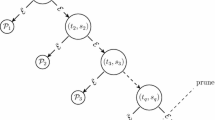Abstract
In bilevel optimization problems there are two decision makers, the leader and the follower, who act in a hierarchy. Each decision maker has his own objective function, but there are common constraints. This paper deals with bilevel assignment problems where each decision maker controls a subset of edges and each edge has a leader’s and a follower’s weight. The edges selected by the leader and by the follower need to form a perfect matching. The task is to determine which edges the leader should choose such that his objective value which depends on the follower’s optimal reaction is maximized. We consider sum- and bottleneck objective functions for the leader and follower. Moreover, if not all optimal reactions of the follower lead to the same leader’s objective value, then the follower either chooses an optimal reaction which is best (optimistic rule) or worst (pessimistic rule) for the leader. We show that all the variants arising if the leader’s and follower’s objective functions are sum or bottleneck functions are NP-hard if the pessimistic rule is applied. In case of the optimistic rule the problem is shown to be NP-hard if at least one of the decision makers has a sum objective function.
Similar content being viewed by others
References
Anandalingam G, Friesz TL (eds) (1992) Hierarchical optimization. Annals of operations research, vol 34. J.C. Baltzer Scientific Publishing Company, Basel
Ben-Ayed O, Blair CE (1990) Computational difficulties of bilevel linear programming. Oper Res 38: 556–560
Burkard RE, Çela E (1999) Linear assignment problems and extensions. In: Du DZ, Pardalos PM (eds) Handbook ofcombinatorial optimization—supplement, vol A. Kluwer, Dordrecht pp 75–149
Burkard RE, Dell’Amico M, Martello S (2009) Assignment problems. In: SIAM monographs on discrete mathematics and applications. Society for Industrial and Applied Mathematics (SIAM), Philadelphia
Colson B, Marcotte P, Savard G (2005) Bilevel programming: a survey. 4OR: A Q J Oper Res 3: 87–107
Dempe S (2003) Annotated bibliography on bilevel programming and mathematical programs with equilibrium constraints. Optimization 52: 333–359
Deng X (1998) Complexity issues in bilevel linear programming. In: Migdalas A, Pardalos PM, Värband P (eds) Multilevel optimization. Algorithms and applications. Kluwer, Dordrecht, pp 149–164
Deng X (1998) Complexity issues in bilevel linear programming. In: Migdalas A, Pardalos PM, Värband P (eds) Multilevel optimization. Algorithms and applications. Kluwer, Dordrecht, pp 149–164
Garey M, Johnson D (1979) Computers and intractability, a guide to the theory of NP-completeness. Freeman, New York
Gassner E (2002) Maximal spannende Baumprobleme mit einer Hierarchie von zwei Entscheidungsträgern (in German). Diploma thesis, Department of Mathematics B, University of Technology, Graz, Austria
Hansen P, Jaumard B, Savard G (1992) New branch-and-bound rules for linear bilevel programming. SIAM J Sci Stat Comput 13: 1194–1217
Jeroslow R (1985) The polynomial hierarchy and a simple model for competitive analysis. Math Program 32: 146–164
Migdalas A, Pardalos PM, Värband P (1998) Multilevel optimization. Algorithms and applications. Kluwer, Dordrecht
Stackelberg H von (1934) Marktform und Gleichgewicht. Springer, Berlin [engl. transl.: The theory of market economy. Oxford University Press, New York (1952)]
Vicente LN, Calamai PH (1994) Bilevel and multilevel programming: a bibliography review. J Global Optim 5: 291–306
Author information
Authors and Affiliations
Corresponding author
Additional information
Partial financial support by the “SFB Optimierung und Kontrolle, Projektbereich Diskrete Optimierung” is gratefully acknowledged.
Rights and permissions
About this article
Cite this article
Gassner, E., Klinz, B. The computational complexity of bilevel assignment problems. 4OR-Q J Oper Res 7, 379–394 (2009). https://doi.org/10.1007/s10288-009-0098-8
Received:
Revised:
Published:
Issue Date:
DOI: https://doi.org/10.1007/s10288-009-0098-8




